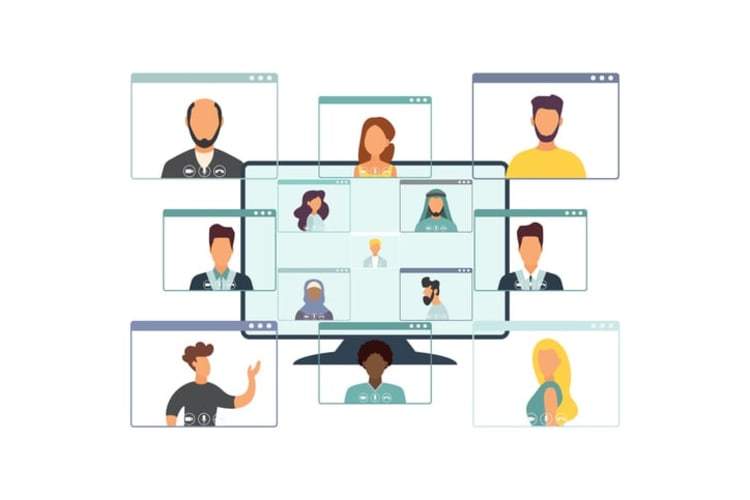Are your team huddles feeling stale and unproductive? Don’t worry; you’re not alone. The key to effective team huddles lies in finding the right balance between structure and creativity. In this blog post, we’ll explore practical tips and ideas to revitalize your team huddle meetings in 2024. By the end of this post, you’ll have the knowledge and inspiration to conduct more engaging, productive, and collaborative team huddles, whether your team is in-person or remote.
Key takeaways
- Team huddles are an effective tool for boosting communication, collaboration and productivity in the workplace.
- Encourage participation with clear agendas and track progress to stay on course and reach goals faster.
- Implement creative ideas such as icebreakers & team building activities to motivate your team & celebrate successes!
The importance of team huddles

Team huddles have their roots in sports, where teams gather to strategize and motivate themselves before a match. In the workplace, daily huddle meetings can be a powerful way to boost team alignment, communication, and productivity. Huddles are used in various industries, from tech to healthcare, to help teams work better together.
We’re going to explore the essential aspects of team huddles that contribute to the effectiveness of modern work environments: enhancing team communication, fostering collaboration, and boosting productivity.
Enhancing team communication
Holding daily team huddles on a regular basis can lead to a marked improvement in communication among team members. A single daily huddle is sufficient to keep everyone updated on the latest company developments and prevent meeting fatigue. Utilizing tools like Kumospace can further enhance team communication by fostering conversations and keeping everyone informed.
Establishing regular team huddles and using effective communication tools like Kumospace can create an environment where everyone stays in the loop and feels comfortable asking for help when needed. This can lead to more efficient problem-solving and collaboration.
Fostering collaboration
A welcoming and inclusive atmosphere during team huddles is fundamental to promoting collaboration. When team members feel comfortable expressing their thoughts and working together, it can strengthen the bonds between them and emphasize the importance of teamwork and collaboration.
Ensuring every team member’s voice is heard and fostering a sense of ownership and accountability can enhance team performance and cultivate a successful team dynamic. This collaborative environment, where each team member contributes, can lead to more innovative ideas and better overall results.
Boosting productivity
To enhance productivity during team huddles, it’s necessary to set clear goals, monitor progress, and celebrate achievements. A motivation huddle can provide the energy and support needed to complete a project or task, helping team members stay focused and on track.
Morning huddles can be especially effective in setting the tone for the day and ensuring everyone starts their day with clear goals and expectations. Employing efficient formats like the daily scrum enables quick and effective coverage of all important daily huddle agenda points, thereby maximizing productivity during the daily huddle meeting. To further enhance the effectiveness of these daily huddles, consider implementing some daily huddle tips. By focusing on only one daily huddle, your team can maintain a consistent routine and reap the benefits of this powerful communication tool.
Best practices for conducting team huddles

For optimal effectiveness of your team huddles, consider implementing these best practices: clear agenda setting, encouraging active participation, and tracking time and progress. These strategies can lead to more engaging and productive team huddles that keep everyone focused and on track.
Incorporating these best practices fosters an environment where team members are motivated and inspired to contribute their ideas and collaborate towards achieving common goals. This collaborative atmosphere can lead to a more successful and productive team in the long run.
Setting a clear agenda

A clear agenda for team huddles helps maintain focus and ensures discussion of all important topics within the stipulated time. Assigning weekly meeting preparation tasks and creating a specific agenda for each huddle can optimize the effectiveness of each meeting.
Emphasizing huddle highlights can also help team members retain essential information and stay up-to-date, even if they missed the meeting. This well-structured agenda ensures that meetings run efficiently and achieve their desired outcomes.
Encouraging participation
Promoting participation in team huddles is key to nurturing a successful and productive team. Here are some strategies to encourage participation:
- Set clear expectations for all team members to contribute to the discussion.
- Reward participation to foster an open and inviting atmosphere.
- Create a safe space for everyone to comfortably share their thoughts and ideas.
By implementing these strategies, you can create a team huddle environment that encourages active participation and collaboration.
Fostering a culture of active participation in team huddles, including the occasional management huddle, can lead to more engaging discussions, better problem-solving, and a stronger sense of camaraderie among team members. This, in turn, can boost overall team performance and productivity.
Monitoring time and progress
Tracking time and progress during team huddles helps maintain momentum, keeps the meeting on course, and aids in achieving team goals quicker. Here are some effective ways to monitor time and progress:
- Set SMART goals
- Break goals into smaller steps
- Define deadlines and milestones
- Document progress
By implementing these strategies, you can ensure that your team stays on track and achieves their goals efficiently.
Additionally, using a dedicated time tracking method and considering reflective writing can help your team stay focused and accountable for their progress. This can lead to more efficient and productive team huddles, ultimately benefiting the entire team.
Adapting team huddles for remote work

As remote work rises in popularity, it has become increasingly important to adapt team huddles for remote teams. Remote teams can still benefit from the advantages of team huddles by choosing the right tools, such as Kumospace, and balancing synchronous and asynchronous communication methods.
Adjusting team huddles for remote work allows you to uphold the benefits of enhanced communication, increased collaboration, and improved productivity among your team members, regardless of their geographical location.
Choosing the right tools
Choosing suitable tools for remote team huddles is vital to facilitate effective communication and collaboration among team members. Platforms like Kumospace offer customizable templates and a range of interactive features, making them perfect for virtual huddles.
These tools can help remote teams stay connected and engaged during team huddles, ensuring that everyone is on the same page and working together effectively. By choosing the right tools, you can make remote team huddles just as productive as in-person meetings.
Kumospace

Kumospace stands out for remote team huddles with its spatial audio and video that allows participants to have more natural conversations by simply moving their avatars closer or farther from others, mimicking real-life interaction. Its collaborative tools, such as shared whiteboards and screen sharing, facilitate real-time teamwork, while the customizable environments enable teams to create a huddle space that suits their culture and meeting objectives.
Additionally, Kumospace offers interactive features for informal social interactions, like virtual happy hours and games, fostering team building and camaraderie in a remote setting. These elements together make Kumospace a versatile platform for both structured team huddles and casual, engaging team interactions.
Balancing synchronous and asynchronous communication
For remote team huddles, striking a balance between synchronous and asynchronous communication is key to accommodate team members in different time zones and foster productive communication. Synchronous communication, like video calls and live chats, allows for real-time connection, while asynchronous communication, such as emails and message boards, offers flexibility in scheduling.
By striking a balance between these two communication methods, remote teams can collaborate effectively and efficiently, ensuring that everyone has the opportunity to contribute and stay informed, regardless of their location or schedule.
Implementing creative huddle ideas

To maintain engagement in your team huddles and cultivate a positive team culture, it may be beneficial to introduce creative huddle ideas. In the following subsections, we’ll explore the benefits of icebreakers and team-building activities, as well as the importance of celebrating successes and milestones during team huddles.
Icebreakers and team-building activities
Incorporating icebreakers and team-building activities into your team huddles helps establish a relaxed and enjoyable atmosphere, thereby encouraging stronger connections among team members. Engaging icebreakers like Draw and Guess, Two Truths and One Lie, or The Desert Island Game can help break the ice and encourage team members to open up and share their thoughts.
These activities not only make team huddles more enjoyable but also foster a sense of camaraderie and unity among team members. Incorporating icebreakers and team-building activities can lead to more effective communication and collaboration within the team.
Celebrating successes and milestones
Allocating time to celebrate successes and milestones during team huddles can significantly boost team morale and motivation. By acknowledging individual and team accomplishments, you can reinforce the value of teamwork and collaboration while also boosting employee engagement and satisfaction.
Incorporating celebrations into your team huddles can help create a positive team culture where everyone feels valued and appreciated. This, in turn, can lead to increased motivation, productivity, and overall team success.
Overcoming common team huddle challenges

While team huddles can offer immense benefits, they also pose certain challenges. In this section, we’ll discuss how to overcome common team huddle challenges such as managing conflicting schedules and handling difficult conversations.
By addressing these challenges effectively, your team can continue to reap the benefits of productive and collaborative team huddles.
Managing conflicting schedules
Managing conflicting schedules among team members is a common challenge in team huddles. To mitigate this issue, it is necessary to:
- Establish a consistent meeting time that suits all team members
- Demonstrate flexibility when required
- Collaborate and talk to each other to make sure the meeting time works for everyone
- Be willing to make changes if needed
By working together and being open to adjustments, team members can ensure that everyone can attend the daily team huddle and contribute to the discussion, despite any scheduling conflicts that may arise during a team meeting.
Handling difficult conversations
While handling difficult conversations during team huddles can pose a challenge, it plays a crucial role in cultivating trust and understanding among team members. To navigate these conversations successfully, it’s crucial to maintain a respectful and open-minded atmosphere that allows for constructive feedback and problem-solving.
By creating a supportive environment for honest dialogue and actively listening to each other, teams can work through difficult conversations and emerge stronger and more unified, ultimately leading to a more productive and collaborative team dynamic.
Summary
In conclusion, team huddles are an essential aspect of modern work environments, helping to enhance communication, foster collaboration, and boost productivity. By implementing best practices, adapting huddles for remote work, and incorporating creative ideas, you can create engaging and effective team huddles that lead to a more successful and motivated team.
Remember that the key to successful team huddles lies in finding the right balance between structure and creativity. With the tips and ideas shared in this blog post, you can revitalize your team huddle meetings and enjoy the benefits of a more connected, collaborative, and productive team.
Frequently asked questions
Team huddles and meetings are both important gatherings for teams, but the major difference is that a team huddle is much shorter and less formal than a team meeting. Huddles usually last less than 15 minutes, while team meetings can go up to an hour or more.
A good team huddle engages all attendees, keeping the discussion interesting and relevant. The chair should ensure everyone has a chance to speak and provide an opportunity for each attendee to be asked how they feel. As part of the problem-solving process, triage any issues quickly and efficiently or take it offline after the meeting.
Stay connected and stay productive with reliable tools like Zoom, Google Meet, Switchboard, Microsoft Teams, and Kumospace for successful remote team huddles.
Let's make team huddles a safe and inviting place where everyone can share their ideas and work together! Let's foster collaboration in our huddles!





